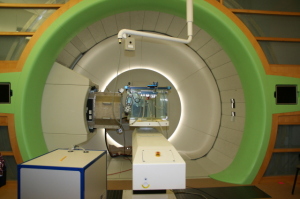by
Barbara Kram, Editor | October 21, 2009

One of UPenn's four
proton therapy gantries
The University of Pennsylvania held a seminar and tour of its new proton therapy center October 15.
While the facility is not treating patients yet, and we don't have the exact opening date, it won't be long before particle beam cancer therapy is available in the Delaware Valley at the Penn Medicine Roberts Proton Therapy Center, 3400 Civic Center Boulevard in Philadelphia.



Ad Statistics
Times Displayed: 45539
Times Visited: 1299 Ampronix, a Top Master Distributor for Sony Medical, provides Sales, Service & Exchanges for Sony Surgical Displays, Printers, & More. Rely on Us for Expert Support Tailored to Your Needs. Email info@ampronix.com or Call 949-273-8000 for Premier Pricing.
A treatment room
under construction
reveals the beam entry
site into the gantry area
In a pre-opening science writers seminar, UPenn and the National Cancer Institute briefed reporters on the therapy.
Stephen Hahn, M.D. Chair, Department of Radiation Oncology, Penn Medicine explained the chief benefit of proton therapy to "improve conformity to limit [radiation therapy] dose to the tumor...without expense to healthy tissues." He outlined the research direction that will be undertaken in conjunction with clinical work at the proton center to answer critical questions: "Who will benefit from proton therapy in a meaningful way we can measure?" and "It's intuitive that less dose is better, but does it translate to benefits to patients?" Also, "Does the positive effect of proton therapy translate into measurable benefit compared to regular radiation therapy?"
Among its promises, proton therapy may enable patients to take drugs that can't be used with conventional IMRT radiation therapy. "We need to find out if new combination therapies translate to lower side effects and higher cure rates ...to improve morbidity and mortality," Dr. Hahn said. "The technology may be the next best thing but we need to know what is best for the patient," he stressed.
A row of energy selector
magnets adjust the
proton beam strength
James Metz, M.D. Vice Chair, Clinical Operations Division, Department of Radiation Oncology explained that proton particles, essentially "scramble the DNA of cells" in a manner similar to conventional radiation therapy. It's a complicated issue to determine which cancers to target with protons. The precision targeting from proton therapy suggests it is applicable for some but not all cancers. Among the likely tumor site targets at Penn are lung, prostate, critical structures like the brain and eye, and pediatric cancers. Other areas of focus may be cancers in which conventional therapy does a poor job of improving outcomes.

